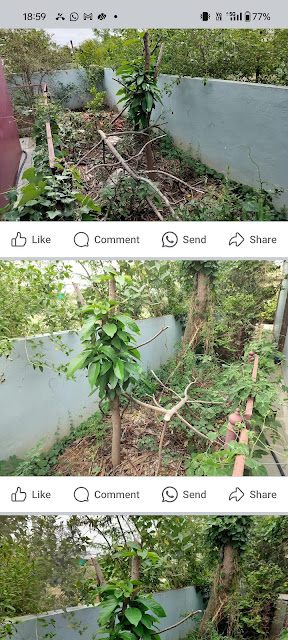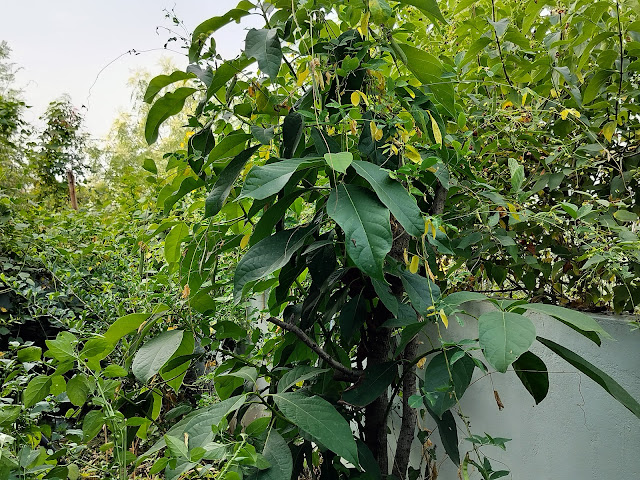Summary/Abstract : We share a plant model as well as human model of vasculopathy encountered in parallel over this week with resultant UDLCO analogies between plant and human pathologies and the similarities and differences in their interventions.
Introduction : In humans, Vasculopathy is the final driver for mortality and morbidity often in non communicable diseases NCD and sometimes also in communicable diseases CD.
Methods : We describe a particular instance of plant gangrene attributed to blockage of plant vascular channels that may have resulted from complex unidentifiable factors either related to NCD or CD.
Results :
UDLCO from CUBE group :
[3/10, 6:42 PM] +91 98205 56421: Thank you for introducing a new correlation between humans and plants.
While travelling from Mumbai to Poona after the first tunnel some champa plants have huge tumors.
Will read about it.
Can you share in another format? Not on Facebook🙃
[3/10, 7:52 PM] Rakesh Biswas: There are 20 images as results which was easy to upload with single clicks in facebook whereas in all other platforms that I use it wouldn't have been easy. Anyway to make blogger uploads easier @Metapsychist Number 1 Kims 2015 ?
I'm working on a blogger post where I try to join the above plant home lab model with the human hospital based model encountered this week
UDLCO from the collective medical cognition group:
[3/4, 4:43 PM] Rakesh Biswas: https://chat.whatsapp.com/
Contrarian to the expected cardio metabolic phenotype and yet has LVH hfref CCF other than damaged lungs due to old TB
[3/4, 4:44 PM] Rakesh Biswas: Right upper lobe fibrosis, cardiomegaly
[3/4, 4:45 PM] Rakesh Biswas: ecg LVH
[3/4, 4:46 PM] Rakesh Biswas: Echo : Note the LVH and extremely poor contractility of the heart
[3/4, 5:02 PM] Metacognitist Mover and Shaker1: Perhaps severe LV strain and an LAFB sir? Any old ECGs?
[3/6, 3:29 PM] Rakesh Biswas: Afternoon session log :
Update :
Day 4
(S)ubjectively: Shortness of breath reduced but can't quantify
Want's to stay till he becomes fully better
(O)bjectively: On room Air with normal SpO2 since day 2
Assessment: CAD CCF COPD secondary to generator pump and bidi poga inspite of a very hardworking and frugal eating life style! Stopped smoking both since 2 years
Plan : Continue supportive pre load reduction. Should we add an afterload reducing agent? What was the reason for his initial cardiogenic shock?
[3/6, 4:25 PM] Rakesh Biswas: Spent an entire afternoon with this patient but the fascinating insights were well worth it!
This patient was a stark contrast to the cardio metabolic phenotypes with trunkal obesity NCD we regularly see here. Nevertheless this too is an important NCD responsible for a lot of mortality!
Inspite of a very hard working life style leaving him with hardly any fat accumulation in his body!
While feeling his loins and lumbar regions while doing his complete visceral ultrasound scan, I could hardly see any fat, he was almost skin and bones) and yet he still managed to get such a severe cardiac failure likely due to vasculopathy.
All because of the genset pump smoke that he used to operate as well as his bidis!
Also captured a lot about his work and life events graph with the help of @Venkat Sai Kims Med 2021 @Kranthi Kims Med Pg 2021 Can they share it in a event sequential time line here?
Overall there is a huge requirement for this kind of data capture and sharing around each patient that when mapped appropriately will show more insights, only if we could develop a mechanism to train and compensate people for doing it?
@Rahul healthcare 2.0 @Metapsychist Number 1 Kims 2015
[3/8, 8:14 PM] Rakesh Biswas: Pending afternoon session logs :
Couldn't meet this man today but I guess he's been shifted to AMC @Pushed Communicator 1N22 ?
Hadn't really logged what was fascinating about the session with him this Wednesday afternoon and I just recalled that there was a lot of discussion around farming and his internal medicine disease producing factors, while one point I had forgotten and that was their family's (including his son and daughter in law's) recent farming entrepreneurship tryst @Rahul healthcare 2.0 @Metapsychist Number 1 Kims 2015 , where they invested their accumulated daily wage labor earnings of many years, into buying a 2 acre farm plot and after using it for some years just for grazing their buffaloes, they recently decided to expand their portfolio by investing in harvesting crops and while last year they had a bounty of 30 quintals of rice, nearly all of which was re invested again this year, they complain that what with his being in the hospital and their also having to be here as well as the extreme dry weather they are bracing for a total crop failure this time and are going to lose a lot of money!
Can we think of tightening the above biopsychosocial diagnosis further in the fact that we need to now look at generalizeable global reasons and solutions to crop failure? What if they had used permaculture techniques planting more biodiversity generating plants with multiple different varieties of seeds instead of traditional methods that thrive on monoculture? Quite relevant to the Plos one article journal club we recently had?
[3/8, 8:18 PM] Metapsychist Number 1 Kims 2015: "Habitat loss for food production is a key threat to global biodiversity. Despite the importance of dietary choices on our capacity to mitigate the on-going biodiversity crisis, unlike with specific ingredients or products, consumers have limited information on the biodiversity implications of choosing to eat a certain popular dish. Here we estimated the biodiversity footprints of 151 popular local dishes from around the world when globally and locally produced and after calorical content standardization."
"The biodiversity footprint was calculated using three biodiversity indicators, namely species richness, threatened species richness, and range rarity affected by converting natural habitat to cropland or pastureland. Additionally, we considered four scenarios, feedlot-grown and locally produced, feedlot-grown and globally produced, pasture-grown and locally produced, and pasture-grown and globally produced. In the globally produced scenarios, biodiversity footprint was calculated based on the global distribution of species and crops, while the locally produced scenarios were calculated at the country level."
Ambiguous ingredient types and measurements
When an ingredient was specified in a generic manner, the top ingredient of that type in terms of global production was assumed. For instance, soybean oil was assumed when only “oil” was mentioned in the recipe.
High-biodiversity-footprint chicken, rice, and legume dishes tended to be from India and included chicken jalfrezi (type of tomato-based chicken curry), chicken chaat, chana masala, idli (savoury rice cake), and rajma (red kidney beans curry) (Fig 2)."
[3/8, 8:18 PM] Metapsychist Number 1 Kims 2015: The critical aspects of permaculture are (i) site characteristics; (ii) interaction between elements at different levels, at both field and agro-system level; and (iii) the spatial arrangements of these elements to create synergies for various socio-ecological functions. For the agro-system level interactions, permaculture emphasizes the close integration of terrestrial and aquatic systems, animal husbandry, and annual and perennial field crop plants.5,6,7 Other components of permaculture include water harvesting structures, agroforestry, organic farming, social sciences, and animal and plant breeding.8
With the Deccan Development Society's support - a development NGO - the first permaculture demonstration farm was established in 1987 in Zahaeerabad district in Andhra Pradesh.
In 2016, Aranya Agricultural Alternatives, a Hyderabad-based organization, and now the main center and promoter of the movement in India, organized the first National Permaculture Convergence (NPC), which brought together more than 1,000 farmers, academics, and permaculture practitioners for the first time The India Permaculture Network originated from this event and is currently promoting permaculture in India in a structured way. In 2017 the 13th International Permaculture Convergence (IC) was held in India under the theme "Towards Healthy Societies."1
[3/8, 10:39 PM] Rakesh Biswas: Pending afternoon session logs from yesterday :
Had an interesting "internal medicine" session around this 70 year old man yesterday after the "external medicine" farming session around him day before yesterday (also shared today above).
He came in cardiogenic shock, evidenced by very low cardiac contractility on Echo, along with his hypotension and the ECGs serially shared here : https://venkanna2023.blogspot.
The first one was similar to what @K. Shiva Sai Nagendra Kims PG 2023 had sent to Nalgonda recently but the next one changed in the subsequent days with ST coving in lateral leads as well as intermittently in V3. The one in V3 appeared three days back as well as yesterday. Day before yesterday he had a transient atrial fibrillation too.
Conclusion : Plant and human animal pathologies of vasculopathy evolving parallely over the week serves to take a better zoomed out view of factors leading to as well as outcomes of vasculopathy and their spectrum of interventions.
Glossary: http://userdrivenhealthcare.
17 June 2024:
Home lab update on the plant model of vasculopathic gangrene that appears to have currently become a model for regenerative medicine with the earlier amputated gangrenous model lying by its side while it's coppicing.
July 2024 update:
November 2024 update:
Further literature review:
Ontogenetic aging, commonly known as the maturation phase, is a common life cycle part of all vascular plant species. Phase changes in the maturation process can be divided into four phases, namely; (1) the embryonic phase, (2) the post-embryonic juvenile vegetative phase, (3) the adult vegetative phase and (4) the adult reproductive phase
Plant regeneration among woody plants, especially from adult trees, is often not successful directly without any cell rejuvenation [4].
Unquote





























